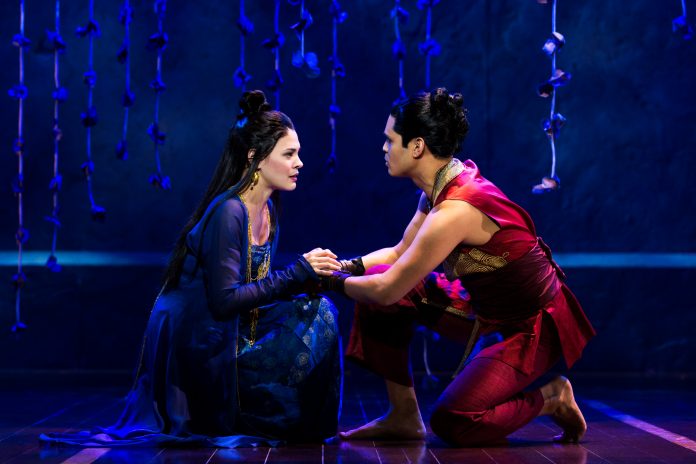By Lynda Lacayo
Audiences will be whistling a happy tune, even after all the 65-plus years since “The King and I” debuted on Broadway. Its New York run earned the show four Tonys, including the 1952 Best Musican honor.
Revivals of the classic musical continue to garner critical and popular acclaim while winning awards. The latest production of ‘The King and I,’ which received the 2015 Tony for Best Revival, takes the stage at the Segerstrom Center for the Arts Feb. 27-March 11.
Audiences are still falling in love with the story of the tempestuous King of Siam and the unconventional Anna Leonowens.
The beautiful, idiosyncratic story about East meeting West is as meaningful today as it was 70 years ago. This production of “The King and I” is “Something Wonderful,” not only because it possesses one of Rodgers and Hammerstein’s finest scores but also because it’s a brilliant musical with a fascinating story based on actual history, magnificent staging, dazzling costumes, and a talented cast.
The beauty and brilliance of the Rodgers and Hammerstein masterpiece was not what motivated multi-talented Kavin Panmeechao—he plays young lover Lun Tia—to audition for “The King and I.” Panmeechao certainly recognizes the timeless musical as “fantastic theater” but says, “For me, the reason I auditioned for the show is that I’m a Thai person and this was the first musical I’d ever seen where the cast actually looked like me. I also felt some affinity towards the show because it takes place in Siam which is now modern-day Thailand. We live in a time that is more culturally sensitive and it’s really important that actors of all types are considered for roles that are ethnically and culturally appropriate.”
He adds, “Ironically, I’m the only Thai person in the show and I play a Burmese emissary. My mom thinks it’s funny that I’m actually Thai and I play one of the only non-Thais.”
“The King and I”’s plot is summarized by Panmeechao as the story of “Siam’s King and Anna, the English governess he hires to teach his royal wives and children about Western customs. Anna and the King’s relationship is a cultural clash between two very different points of view. The show’s theme is really about that ethnical exchange as East meets West. It is that idea of promoting cultural dialogue, as well as themes of fighting a patriarchal society and sexism that make this musical very pertinent today.”
Modern audiences respond to “The King and I” as if it was newly minted yesterday and not back in the 1950s. The superb score written by Rodgers and Hammerstein contributes, of course, to its timelessness and universality. Fans of the classic will waltz out of theaters humming such masterpieces as “Hello, Young Lovers,” “Getting to Know You,” “Shall We Dance,” and the list goes on.
Panmeechao, however, believes “The King and I”’s appeal is greater than just the sum of its glorious parts—the music, staging, scenery, costumes, and choreography. He says, “In our production we really highlight the plight of women. What the show is really about are three women, one fights the system, one works within it, and one runs away from it. In our specific cultural climate respect towards women is an important topic of discussion. That current society is addressing the same issue that was written about decades ago is why I think this show has such universal appeal.”
“The King and I” tackles politics and passion as well as women’s rights and cultural differences. Lun Tai, a Burmese envoy, exemplifies this, moving the plot along in a more modern manner. Panmeechao describes his character, saying, “as Lun Tai escorts the Burmese Princess Tuptim to the court of Siam as a gift to the king, the pair falls in love. It’s their love that drives the musical’s action. The romance is treacherous because Tuptim is an offering meant to strengthen political ties between Burma and Siam. She represents peace and unity between the kingdoms so their love affair has serious repercussions for social stability.”
According to Panmeechao, “Thailand (Siam) in the 19th century is a very different paragon than it is today.”
Yet, there is one line that made him gasp aloud in rehearsals because it underscores the show’s relevance. He explains, “The line was written in 1951 by Oscar Hammerstein. The king is talking about Western encroachment on Southeast Asia and the colonialism happening around him. He’s trying to figure out a way to protect his country and he says, ‘One day, I wish to build a fence around Siam.’ Regardless of people’s political leanings, audiences reacted strongly to that because it so closely mirrors the rhetoric we have heard lately. I thought how odd and how current the writing is in the show.”
The musical numbers in “The King and I” reads like a hit list from the Great American songbook. They are, after all, compositions of the creative genius of Rodgers and Hammerstein. Of the many standards there are a couple that Panmeechao favors. He says, ‘Something Wonderful’ is just a glorious song with beautiful sentiment and Joan Almedilla (Lady Thiang) sings it exquisitely.”
He continues, “Ironically enough, my other favorite is ‘Western People Funny.’ In this production we’ve changed the intention behind the song without changing any of the lyrics. Instead of the Asian people seeming simple, we switched it around so the Siamese people are literally singing ‘look how ridiculous you make us look in corsets and hoop skirts’, like crazy people but really it’s Western people who are funny, yeah they are. I love this song because it pokes fun at Western concepts of beauty and appropriateness.”
In a production packed with show-stopping songs and splendid moments, the highlight for Panmeechao is the ballet originally choreographed by Jerome Robbins and adapted for the show by Christopher Gattelli. He says, “The presentation of ‘Uncle Tom’s Cabin’ in Siamese-type movements is an amazing piece of theater and thrilling storytelling done through the choreography. Robbins created the work based on a book with pictures and diagrams illustrating East Asian movement. It’s fascinating because the physical gestures are very Siamese but are actually borrowed from other Eastern traditions, such as Balinese, Chinese, and Japanese dance styles.”
“Shall We Dance” to the Segerstrom Center for the Arts, Segerstrom Hall Feb. 27-March 11 for the Lincoln Center Theater Production of “The King and I?” Tickets and information at The Box Office, 600 Town Center Dr., Costa Mesa; phone 714-556-2787 or online at SCFTA.org.
 Kavin Panmeechao
Kavin Panmeechao









